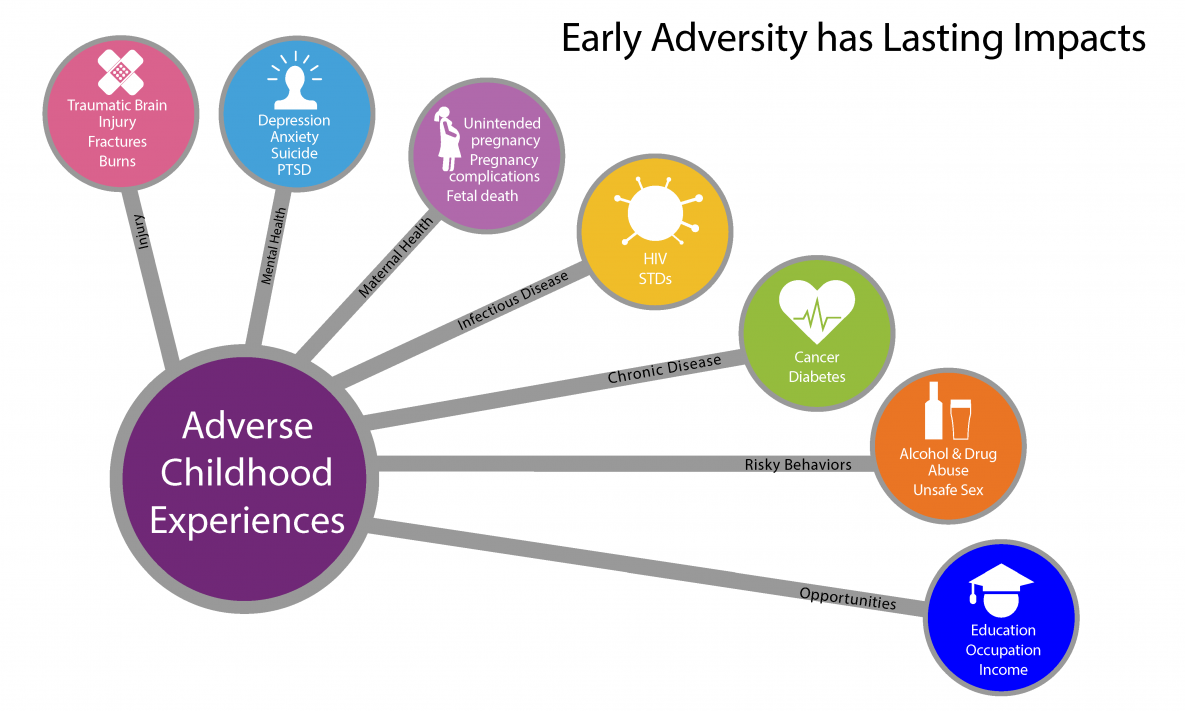The Biological Basis of Trauma: Part 3: Trauma and Adult Health
This is the last blog in a three-part series delving into the biological basis of trauma. The purpose of this series is to help develop insight into how trauma affects us, so that we can understand how to work with the havoc it has wreaked in our lives. Remember as you read this series, this is not an unchangeable tale of doom. If you are alive, you have the potential to change your narrative. Yes, trauma does change us. Our minds and bodies developed to survive dreadful, violent realities. So, yes, we are different. But different does not mean defective. So use this information to help you understand the demons you tango with, so that you can move forward in creating the story you want to live!
Back in the 90’s, a group of scientists teamed up with the CDC to research if childhood trauma effected adults health. To conduct this study they sent out questionnaires to thousands of adults. Part of the questionnaire asked for details about health problems and risk factors for developing health problems. The other part asked about exposure to Adverse Childhood Experiences (ACE). ACE’s are potentially traumatic events that occur in childhood (ages 0-17). The list includes things that happened to the child as well aspects of the child’s environment. The ACE study, as it came to be known, was one of the largest studies of its kind ever conducts, with over 17,000 participants from a “typical” middle class population. And the correlations they found were frightening.
First, the amount of participants that were exposed to trauma was disheartening. Twenty-six percent of participants acknowledged experiencing 1 ACE. Nearly 16% reported experiencing 2 ACE’s, 9.5% experienced 3 or more, and 12.5% experienced 4 or more. This means that over 60% of participants reported being exposed to one or more traumatic events during their childhood.
The researchers also found, what many had suspected, that childhood trauma does effect adult health. What they also discovered was that these correlations were massive. Once researcher even described the numbers as being of pandemic proportions. So what exactly did these researchers find? Let’s look at just a few examples.
If exposed to 4 ACE (an ACE score of 4), an individual was 1,350% more likely (than someone with an ACE score of 0) to be an injection drug user. If exposed to 6, the individual was a 4,600% more likely to be an injection drug user. An ACE score of 4 or greater was more than 460% more likely to be depressed, and 1,220% more likely to have attempted suicide.
These findings didn’t just involve mental health, though. ACE score of 4 or more and a person was 390% more likely to have COPD. For every increase in the ACE score if 1 point, the risk for developing an autoimmune disease such as type 1 diabetes, lupus, rheumatoid arthritis went up by 20%.
The numbers and facts don’t stop there, though. Exposure to trauma effects a person’s relationships and life. For example, a person with an ACE score of 4 or more is eight times more likely to be raped later in life. Women who have an ACE score of 5 or more are three times more likely to be victims of domestic violence.
The CDC page on this study summarized it well: “ACEs can have lasting, negative effects on health, well-being, as well as life opportunities such as education and job potential. These experiences can increase the risks of injury, sexually transmitted infections, maternal and child health problems (including teen pregnancy, pregnancy complications, and fetal death), involvement in sex trafficking, and a wide range of chronic diseases and leading causes of death such as cancer, diabetes, heart disease, and suicide.”
You may be wondering at this point, especially if you have read all three parts of this series, why I am telling you all of this. It all sounds so negative, so overwhelming. Like there’s nothing that can be done. But, that simply isn’t true. I’m sharing all of this information for three primary reasons:
1) To help educate those that haven’t been through trauma. A person who hasn’t been traumatized, or traumatized in a way they can understand, often does not truly get how hard it is. They don’t understand the struggles we go through. Even if they don’t think it’s all psychobabble bullshit, they still can’t honestly see why it’s all so difficult. This information can help them understand.
2) To validate your struggle. There is this mentality in our culture that we just need to get over things. You hear things like, “It happened when you were a kid. That was like decades ago. Just get over it already.” Also, many of us experienced covert forms of trauma. We weren’t molested or beaten. So the scars aren’t so easily visible. We can sometimes feel like our suffering wasn’t real. Like everything we went through wasn’t that bad. We undermine our own feelings, memories, and selves. I am hoping that seeing these facts and figures, helps you understand that your fight is real. Your feelings and fears are valid. Experiencing trauma can and does make life harder.
3) To give you hope. This may seem contradictory given the negativity of all of this information. But, for me, all of this information is hopeful. Why? Because with it, I can clearly see the shitty hand I got dealt. And I can then realize how freaking awesome I am doing at the game given this hand!
I have an ACE score of 6. Let’s pretend that life is a mountain we have to climb. Those with no trauma get to start climbing at the bottom. Hell, some people had so much love and so many resources, they took a ski lift part of the way up before their feet even touched the ground. With my childhood (and genetics), it was equivalent to someone digging a pit at the bottom of the mountain. Before I could even start climbing, I had to scrabble and struggle to even get to level ground before I started the climb. So yes, I may only be ¼ of the way up my mountain. But knowing what I know about trauma, and how it affected me, I can now understand what an accomplishment ¼ of the way up is. Hell, I can even understand what accomplishment just getting out of the pit was! I am hoping this information can do the same for you.
If you’re wondering what kinds of experiences are on this ACE questionnaire, or wondering what your own ACE score is, I suggest this questionnaire. It is the closest to the original study. You will also notice at the bottom there is a resilience questionnaire. This is where the hope really starts to begin: with resiliency. All things exist in balance. Trauma is one side of a scale. The other side is resiliency and growth. This will be the next topic we dive into!
For those of you interested in the ACE study and the numbers I presented, I offer these resources:
The first paper published on the ACE study
Long-term effects of childhood trauma
Healing Neen: This documentary is an excellent look at the facts and figures as well as personal, intimate reality of childhood trauma and its effects on us throughout life.



